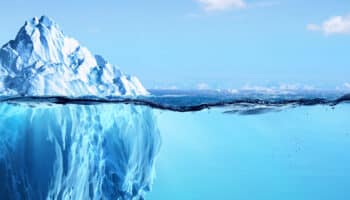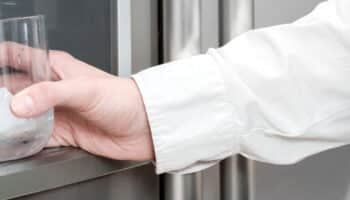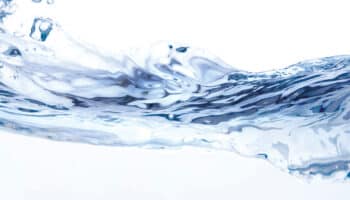Are you searching for a new ice maker, but all the information available is overwhelming?
You’re not alone! In fact, several thousands of people find themselves in a similar situation every year.
Buying a new appliance for your home is never easy – at least not when you’re trying to make the best investment possible. Oftentimes, purchasing a new ice maker is as big a commitment as replacing your refrigerator, so deciding between so many options can be confusing.
It’s estimated that the Ice Maker manufacturing industry in America is worth about $976.9M, so it’s not surprising that when you’re looking for a new model, you’re bombarded with information from several brands.
I know you’re overwhelmed, but don’t worry, you came to the right place for answers.
With 7 years of experience covering all things appliances, I’ve seen my fair share of dissatisfied customers, and faulty machines. I want to help save you hundreds of dollars on repairs and answer your most burning questions., which is why I’ve prepared the guide below.
This way, you’ll rest easy every day knowing that you bought an ice maker that’s actually making ice and not just puddles on your kitchen floor.
Keep reading for an endless ice supply!
Ice Maker Types
Modular
Modular ice makers are typically found in restaurants, bars, and other commercial settings, as they’re bulky and not particularly small. That being said, it’s not unheard of for some people to have this appliance in their homes.
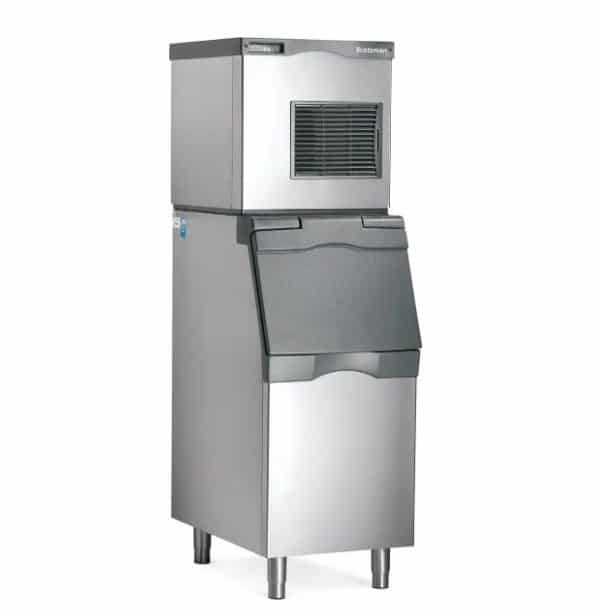
This ice maker type requires a steady water supply, and thus a water line in order to work as expected. Moreover, since it’s a complex unit meant for commercial use, it will require professional installation, which can be expensive. On the positive side, it can provide several kg of ice every hour and is ideal for larger households that either host events often or have numerous family members.
You can expect to pay anywhere between $2,000-10,000 for one of these.
Underconter
Undercounter Ice Makers are great for saving space, since, as their name suggests, they’re meant to be installed and kept under the kitchen countertop. Most of these appliances come with an integrated drain line and can produce ice relatively quickly, as well as keep it frozen in their bin.

These ice makers are great for people who want an integrated look in their kitchen and need to have ice at their disposal quickly. That being said, they are expensive and may require professional installation.
On average, you can expect to pay between $500-3,500 for one of these models.
Countertop
Countertop Ice Makers are very similar to undercounter units, except that they go over your kitchen cabinetry, not under. Given that they do not have to fit into a specific area, these units rarely ever pose any installation challenges.
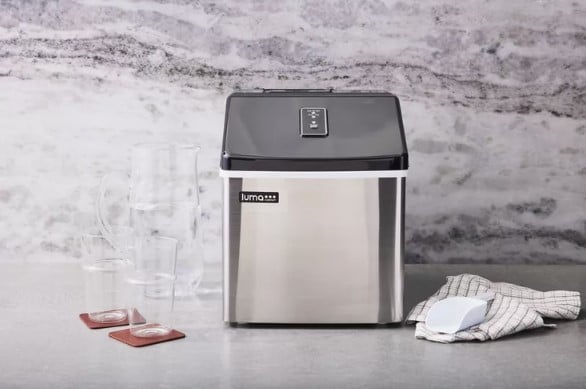
These appliances are great for independence, as they can be placed virtually anywhere in your kitchen and tend to require less maintenance than other ice maker types. If you don’t mind filling the unit’s reservoir now and then and have moderate ice needs every day, this might be the model for you.
Generally speaking, you should expect to pay between $150-550 for this ice maker type.
Portable
Portable Ice Makers are the cheapest type on this lot and for good reason. While they provide great advantages, such as complete freedom of movement and ease of transportation, they’re also known for requiring constant reservoir refills and not being great at preventing ice melting.

These ice makers are great for people who are looking for an affordable appliance that does not require professional installation or is extremely complicated to use. Given their size, they’re more than enough for a family of up to 2 people.
These units go for anywhere between $100-300.
Built-In
Built-In Ice Makers are the best solution for people who take kitchen aesthetics seriously. This appliance type can be installed in your bar or kitchen area to provide a seamless and classy look that pleases the eye.
They’re great at producing ice quickly and can last up to 10 years if properly cared for. That being said, given their complexity, they require professional installation, and their price tag is not too budget-friendly.
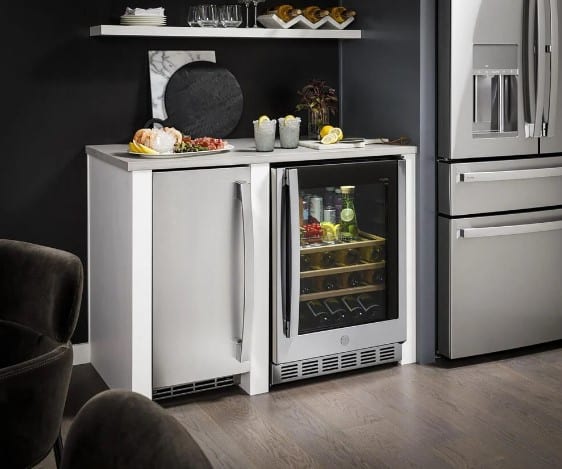
These ice makers are great if you’re ok with paying a considerable amount of money for an endless ice supply that fits right into your kitchen area. If you live with several people, a Built-In ice maker might be the right choice for you.
You can expect to pay anywhere between $1,000-5,000 for this unit once you’ve considered materials and cost of labor.
Ice Maker Buying Considerations
Having covered the most popular ice maker types available on the market, let’s move on to discussing some of the critical elements that should be on your list of priorities before going shopping. Considering them all is a surefire way of preventing bad investments and frustrating disappointments.
#1 Price
Price, regardless of what is being bought, tends to be the dominating concept in people’s minds, and it’s understandable – especially when it comes to an investment this big.
As we touched on earlier, the amount of money you’ll have to pay for your new ice maker will vary greatly depending on the type that you choose and the features that you want it to have. It can be tempting to go all out and get the most expensive model you can afford, but there’s really no point in paying hundreds or thousands of extra dollars for features you might never use.
To better understand the price differences between lower and higher-end models of each ice maker type, please look at this table closely:
| Ice Maker Type | Low-End | Average | High-End |
| Modular | $2,000 | $6,000 | >10,000 |
| Undercounter | $500 | $2,000 | >$3,500 |
| Countertop | $150 | $350 | >$550 |
| Portable | $100 | $200 | >$300 |
| Built-In | $1,000 | $3,000 | >$5,000 |
#2 Size
Size is often not considered to be as important as other concepts, but trust me, it can be the difference between a successful purchase, and a decade-long feeling of buyer’s remorse.
In an ideal world, everyone would have a kitchen big enough to accommodate any ice maker on the market. But in reality, there will always be space constraints, and you must take them into account before spending your hard-earned money.
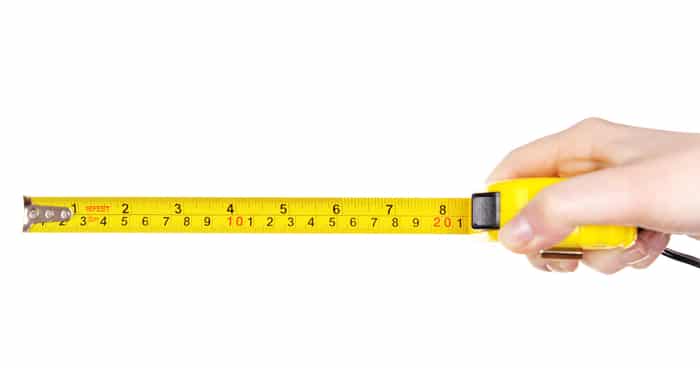
If you’re looking into buying a portable or countertop unit, you might not need to be as careful, but if you’re interested in any other ice maker type, measuring correctly is critical.
Now, a lot of people don’t know this, but when measuring for your new appliance, you must always leave enough breathing room for it to work normally. This means that you should leave at least 3–4 inches of free space between the edges of your ice maker and the surrounding walls/cabinets.
So, if you’re planning on placing your appliance in a space that’s 40 inches (ca. 1 m) wide, make sure that the unit isn’t wider than 37 inches (0.94 m).
#3 Production Capacity
Production capacity should also be at the top of your list of priorities, as it can help you determine whether a specific ice maker type and model is worth the money you’ll be paying. After all, no one wants to make an investment like this only to run out of ice every couple of hours!
Typically, larger ice makers will have larger production capacities, but given how expensive higher-end models can be, it’s essential that you make sure that you truly need that much ice before going shopping.
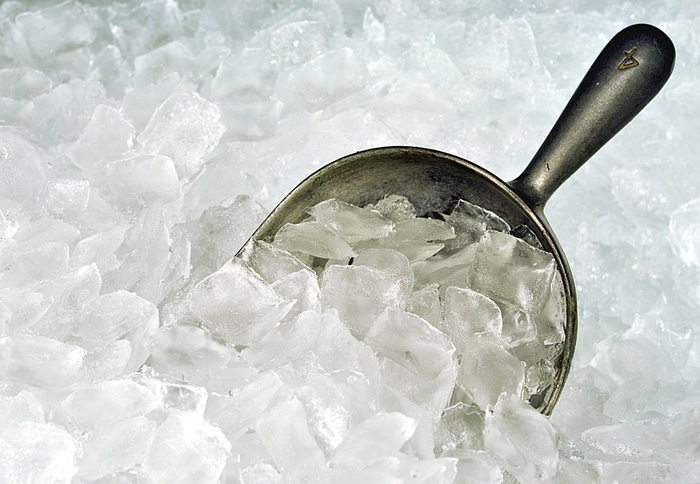
Here’s a table illustrating the most common 24-hour yield capacities for each appliance type:
| Ice Maker Type | 24-Hour Ice Yield Capacity (lbs) |
| Modular | 100-500 |
| Undercounter | 50-80 |
| Countertop | 20-25 |
| Portable | 20-30 |
| Built-In | 50-70 |
#4 Installation Requirements
Installation requirements should be one of the first things you research prior to making a purchase, as the cost of placing a new ice maker in your home can sometimes match or even exceed the price of the unit itself.
As I mentioned earlier, some ice maker types depend on a water line, and others need to be secured onto your cabinetry or bar countertop. These are all things that typically need to be taken care of by a professional, and the cost of labor is rarely ever low.
If you’re already on a budget and don’t want to break the bank further after purchasing your appliance, I strongly recommend going for either a Portable or a Countertop unit. These tend to be the most independent models, and coincidentally, among the cheapest ones as well.
Provided you’re willing to shell out a few thousand dollars, the sky’s the limit. Just make sure that you hire a trained professional to take care of the installation. The average cost of setting up a Built-In unit can reach $500, or more, so you want to make sure that you get it done right the first time!
#5 Maintenance Requirements
Maintenance requirements are also a key element to consider when looking into buying an ice maker. This will determine how much time you’ll have to dedicate to caring for the appliance, and how much time you’ll have to enjoy cold drinks.
The more complex the appliance, the more maintenance it will need, and the more expensive the repairs. To put this into perspective, something as simple as your ice maker not getting any water could be a sign of a greater problem that could burn a hole in your pocket.
One of the most common causes of appliance malfunction is improper maintenance and neglect. If you’re not particularly fond of having to pay your ice maker too much attention, I’d recommend buying a simpler unit, such as the Countertop one.
#6 Features
Features are the make or break of every ice maker, as they justify whether they’re worth the price tag on them.
Typically, the more expensive an appliance is, the wider the range of options it will have, but the vital question to answer here is, how many bells and whistles do you really need? Some people might not be content with anything other than the best of the best, whereas others can make do with as little as possible.

When it comes to ice makers, the main features you can get for your money are:
- Ice types: Different drinks might require different ice shapes and sizes, so having an appliance that can offer different options is always welcome.
- Removable bins: Many large units have removable ice bins which allow you to empty the container out in a cooler for a party, for example.
- Portability: Finding a non-portable ice maker type that can still be moved around safely can be a great advantage.
- Water line capabilities: Many larger ice maker models must be plugged into a water line in order to work. This might seem like an inconvenience, but I like to see it as a feature. After all, having an endless water supply means you’ll never have to manually refill the reservoir.
Most basic models will have only one or two of these features included, whereas high-end, more complex alternatives will likely have them all.
#7 Ratings & Reviews
Ratings & Reviews are one of the most powerful tools at your disposal as a potential appliance customer. Before the internet, we had to rely on word of mouth to know whether a particular machine was all it promised to be. But these days, you can quickly get all the information you need in just a couple of clicks.
Even reputable companies that have been around for decades can make mistakes occasionally. This might be in the shape of a design flaw, or the use of low-quality materials to save on costs.
Whatever the case may be, it’s always a good idea to hear what people have to say about an ice maker you’re interested in.
I recommend going to a large online marketplace, such as Amazon, and searching for the appliance model you want. Read the 20 best and worst reviews and take notes on what people are happy/angry about.
Also, check the 5-star review percentage and see if it’s 80% or more. If it is, the product is probably very good.
Choosing Your Ice Maker
Now that we’ve covered all there is to know about ice makers, it’s time to answer the age-old question.
Which ice maker should you choose?
Well, no one can answer that better than you. With the information provided in this guide, you should be able to make a solid comparison between different ice maker models and types. Remember to take into account not only the people you live with, but also your daily habits, and how often you host large parties at your house.
At the end of the day, while there’s no one-size-fits-all rule, you’re now one step closer to purchasing an ice maker you can enjoy for years.
Frequently Asked Questions
How Much Ice Do I Need?
This depends greatly on a number of factors, including how many iced drinks you and your family enjoy per day, how hot the weather is where you live, and whether you’re planning to use a cooler to keep the ice frozen.
Typically, a family of 4 should be covered and have ice to spare with any machine that can produce at least 20 kg (ca. 44 lb) per day.
How Long Should an Ice Maker Last?
On paper, most large ice maker models can last up to 10 years; however, this will only be true if you maintain the appliance often, repair it as soon as something goes wrong, and use it as designed.
Failing to do any of these things could significantly reduce the unit’s lifespan, leaving you in the unfortunate position of having to buy a new one sooner than expected.
Do You Need a Water Filter?
Maybe. Water filters in ice makers are used to produce crystal-clear ice, as well as filter out any impurities. However, if you don’t mind getting cloudy ice and know that the water in your area is clean, free of mineral deposits, and safe to drink, there’s really no need to spend extra money on an add-on like this.
How to Clean an Ice Maker?
This process will greatly depend on the specific instructions of your appliance’s manufacturer, but for most intents and purposes, you’ll need to unplug the unit and then remove the bin, as well as any excess ice/water.
Once you’ve done that, use a mixture of water and mild detergent to clean the interior and exterior surfaces of the machine until everything is disinfected and spotless. Let the appliance dry completely, and then plug it back into the wall outlet to test it out.
What Are the Telltale Signs That I Need a New Ice Maker?
The easiest way to tell when it’s time to retire your trusty appliance is by looking at how often it fails/breaks down. If this happens more than once per year, and you’re sure you’re using it the right way, chances are you need a new unit.
Another telltale sign of this is noticing that suddenly the machine is making ice that tastes bad, as this could be an indication of a larger issue. There are several other reasons that could be to blame for this, but if your appliance is already over 10 years old, it’s a possibility you can’t rule out.





